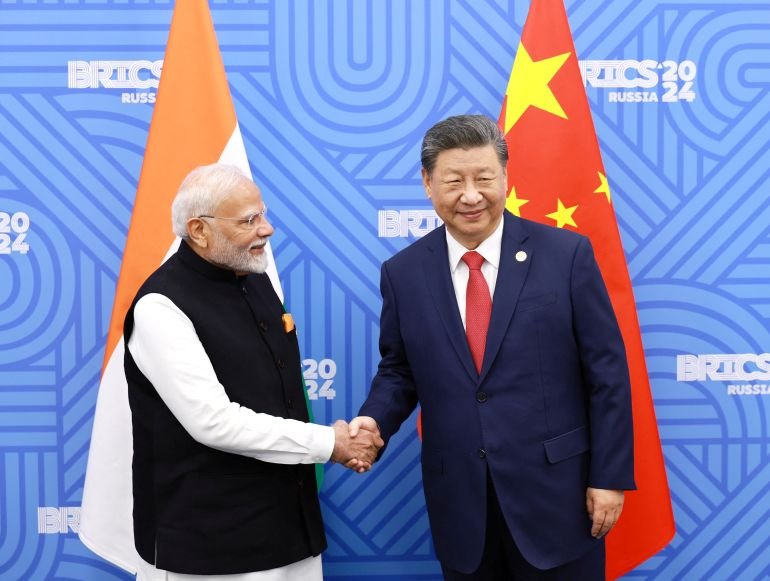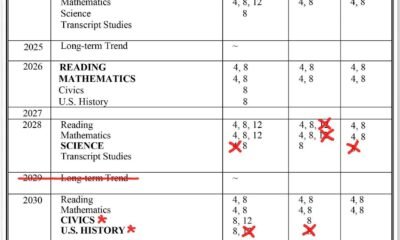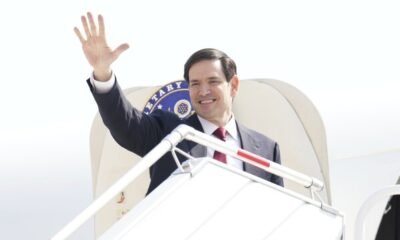Top Stories
Can the new India-China bonhomie reshape trade and hurt the US in Asia? | Donald Trump

New Delhi, India – Five years ago, United States President Donald Trump was being welcomed in India, and China condemned.
In February 2020, Trump addressed a massive rally titled “Namaste Trump!” in Ahmedabad, on his first visit to India as US president, as bilateral ties and trade soared, and the American leader’s personal bonhomie with Prime Minister Narendra Modi was on public display.
By June that year, relations with China, on the other hand, came crashing down: 20 Indian soldiers were killed in clashes with Chinese troops in Galwan Valley in the Ladakh region. India banned more than 200 Chinese apps, including TikTok, and Indian and Chinese troops lined up along their disputed border in an eyeball-to-eyeball standoff. New Delhi also expanded defence and strategic cooperation with the US and the Quad grouping, officially the Quadrilateral Security Dialogue, which also includes Japan and Australia.
As recently as May this year, India treated China as its primary adversary, after Pakistan used Chinese defence systems during its four-day war with India after a deadly attack in Indian-administered Kashmir.
But Trump’s tariff wars, especially against India – which has been slapped with a 50 percent duty on its imports – and rapid geopolitical shifts have led to a thaw in New Delhi’s relations with Beijing.
The White House under Trump, meanwhile, political analysts say, is undoing decades of diplomatic and strategic gains foundational to its influence in Asia, home to more than 60 percent of the world’s population.
“Dragon-Elephant tango”
Earlier this week, Prime Minister Modi sat down with China’s top diplomat, Foreign Minister Wang Yi, as he hailed “respect for each other’s interests and sensitiveness” and “steady progress” in bilateral relations.
On his two-day visit to New Delhi, Wang also met with Indian Foreign Minister S Jaishankar and National Security Adviser Ajit Doval to discuss the countries’ disputed border in the Himalayan mountains.
China’s Ministry of Foreign Affairs said the countries have entered a “steady development track” and should “trust and support” each other. In their meetings, both sides announced confidence-building measures: resumption of direct flights, easier visa processes and border trade facilitation. In June, Beijing allowed pilgrims from India to visit holy sites in Tibet. The two countries also agreed to explore an “early harvest” settlement of parts of their long, contested border, which is the biggest source of historical tensions between them, including a war they fought in 1962.
Modi also formally accepted an invitation from Chinese President Xi Jinping to attend the Shanghai Cooperation Organisation summit in Tianjin – a regional grouping led by China and Russia that many analysts view as aimed at countering US influence in Asia – scheduled for late this month. It will be Modi’s first visit to China in more than seven years.
“The setbacks we experienced in the past few years were not in the interest of the people of our two countries. We are heartened to see the stability that is now restored in the borders,” Wang said Monday, referring to the Galwan clashes, in which four Chinese soldiers were killed as well.
Earlier this year, President Xi called for Sino-Indian ties to take the form of a “Dragon-Elephant tango” – a reference to the animals often seen as emblems of the two Asian giants.
Sana Hashmi, a fellow at the Taiwan-Asia Exchange Foundation, told Al Jazeera that the efforts to minimise tensions and differences between India and China have been under way for some time.
Last October, Modi and Xi broke the ice with a meeting in Kazan, Russia, after avoiding each other for years, even at multilateral forums.
“However, Trump’s policies on tariffs and [favourable approach towards New Delhi’s rival] Pakistan have left India with little choice but to reduce the number of adversaries, including China,” she said.
The US has twice hosted Pakistan’s army chief, Asim Munir, this year, including for an unprecedented White House meeting with Trump. The US president has also repeatedly claimed that he brokered the ceasefire that ended the fighting between India and Pakistan in May, despite New Delhi denying that Washington played a mediator.
“For Beijing, the outreach [towards India] appears largely tactical, while for New Delhi, it stems more from uncertainty and the shifting geopolitical landscape,” Hashmi said.
While there are no visible signs that Trump is seeking to isolate China, Hashmi said the White House “is certainly trying to isolate a key strategic partner, India.”
Trump has imposed an additional 25 percent tariff – on top of another 25 percent – on India’s goods, citing its continued imports of Russian oil. He has not imposed such tariffs against China, the largest buyer of Russian crude.
Biswajit Dhar, a trade economist, said that the Trump tariffs are causing a realignment in Asia. “The pace of improvement [in India-China relations] has certainly hastened over the past few months,” he said.
“There seems to be a genuine shift in the relations,” he added, “which is here to stay.”

Asian trade bloc?
Political and economic experts also noted that if India-China ties were to get warmer, that could soften the blow of US tariffs for both.
With Washington raising barriers on key Indian exports, access to Chinese markets, smoother cross-border trade and collaborative supply chain networks would help New Delhi reduce its reliance on the US market.
In 2024-25, India recorded a trade deficit of $99.2bn with China, backed by a surge in imports of electronic goods. Beijing is India’s largest trading partner after the US – yet, India’s trade deficit with China is roughly double that with the US.
China is attempting to woo India and has indicated that it will provide greater market access for Indian goods, said Hashmi, of the Taiwan-Asia Exchange Foundation. “This could offer India some relief from Trump’s tariffs and mitigate the impact of strategic and economic vulnerabilities and also help reduce the significant trade imbalance India currently has with China,” she said.
For China, winning India over would also be a major strategic gain for its influence in the Asia Pacific, Hashmi said. “New Delhi has been a key pillar of the US-led Indo-Pacific strategy, so closer ties with India would allow China to demonstrate that it, rather than the US, is a reliable economic and security partner,” she added.
Both in India and China, there is a realisation that they have lost too much geostrategically due to their tense relationship, said Ivan Lidarev, a visiting research fellow at the National University of Singapore’s Institute of South Asian Studies, specialising in India-China relations.
“China realised that it has pushed India way too close to the US, and New Delhi realises that its close relations with the US now cost it to a great extent,” he said.
“The China-India rapprochement creates greater space for Asia-led trade blocs that are independent from Washington,” Lidarev said, adding that there could be an increase in the bilateral trade between India and China.
However, Hashmi pointed to limitations that she suggested were in-built into how closely India and China could cooperate. India, like several other countries, has been trying to derisk its supply chains by reducing overdependence on any one source. That, she said, “is proving ineffective without a strong response to the growing dependence on China”. And for India, “this challenge has only deepened with the new US tariffs”.
“A thaw in relations may help normalise bilateral ties, but it is unlikely to transform them, as competition and conflict will persist,” she told Al Jazeera. “[And the] global trade dependence on China will continue, as countries rush to normalise economic relations with Beijing amid Trump’s tariffs.”

Quad, minus the edge
Since the George W Bush presidency, India has been framed in Washington as a democratic counterweight to China. Barack Obama’s “pivot to Asia” gave New Delhi a central role in balancing Beijing’s rise – that only grew sharper with the creation of the Quad, which includes the US and India alongside Japan and Australia.
For the US, the Quad became a centrepiece of its Asia Pacific strategy, steering billions of dollars into Asia Pacific infrastructure, supply chain resilience and critical technologies. Experts noted that the Quad allowed the US to project influence without relying solely on formal alliances, while still embedding New Delhi in a cooperative security and economic framework.
Since the Cold War era, New Delhi has pursued a foreign policy premised on strategic autonomy – it will partner with different countries on specific issues, but will not join any military alliance and will not ideologically position itself in a bloc against other major powers.
Still, in Washington, the underlying assumption was that closer US-India ties, coupled with historical distrust between New Delhi and Beijing, would turn India into a critical pillar against China. To keep India on board, successive US administrations steered clear of pressuring New Delhi too much over its traditional friendship with Moscow, a major weapons supplier to the South Asian nation over the past half-century. That policy continued during Russia’s war on Ukraine, and the US, in fact, encouraged India to buy Russian oil that Western nations were boycotting, to keep global crude prices under check.
Now, Trump is upending that equation and wants India to formally pick a side.
Referring to India’s foreign policy, White House Counsellor for Trade and Manufacturing Peter Navarro wrote in the Financial Times on August 18, “The Biden administration largely looked the other way at this strategic and geopolitical madness. The Trump administration is confronting it … If India wants to be treated as a strategic partner of the US, it needs to start acting like one.”
Indian officials, meanwhile, have signalled that New Delhi will not give up on its “strategic autonomy”.
Warming India-China ties would complicate US efforts to isolate China in global institutions, said BR Deepak, professor of Chinese studies at the Jawaharlal Nehru University (JNU), New Delhi.
“If New Delhi were to align more closely with Beijing on issues like development financing, multilateral reform, de-dollarisation, or climate change, it would undercut Washington’s narrative of rallying democracies against China,” Deepak told Al Jazeera, adding that it lends legitimacy to Beijing’s push for an alternative global order.
Deepak said that a friendlier Beijing-Delhi line might temper India’s appetite for overtly anti-China positioning within the Quad, nudging the grouping towards a broader agenda of providing public goods in the Asia Pacific rather than functioning as a blunt counter-China bloc.
Lidarev, of the National University of Singapore, said that the India-China rapprochement will create “complications within the Quad that will undermine the mutual trust within the grouping and the sense of purpose”.
Still, Deepak said, the Quad’s “strategic relevance” will remain intact, especially over “shared goals such as resilient supply chains, emerging technologies, climate cooperation and maritime security”.
Hashmi pointed out that Trump had focused heavily on strengthening the Quad in his first term – but was now undermining its cohesion.
Right now, the Asia Pacific “doesn’t seem to be a priority” for the US president, she said. But if that changes, Washington will find an altered regional landscape too, she suggested: Convincing India to be a part of any anti-China coalition will prove difficult.
Top Stories
Russia says it will not discuss foreign troops in Ukraine in ‘any format’ | Politics News

Foreign Ministry spokeswoman says deployment of a post-conflict security force would be ‘fundamentally unacceptable’.
Published On 4 Sep 2025
Russia has flatly rejected the prospect of any talks that consider the deployment of foreign troops in Ukraine.
Ministry of Foreign Affairs spokeswoman Maria Zakharova said on Wednesday that Moscow would not entertain discussion of an international post-conflict security force “in any format”.
“Russia is not going to discuss the fundamentally unacceptable and security-undermining foreign intervention in Ukraine in any form, in any format,” Zakharova told reporters on the sidelines of the Eastern Economic Forum in Vladivostok.
Zakharova said that European leaders, who are working on plans for a multinational force in the event of an agreement to end the war in Ukraine, should take note that the “next time they aim to discuss this topic, they should have a pointer in the form of Russia’s position”.
“Judging by Ukraine’s losses, the European Commission has simply outdone itself,” she said.
Zakharova made her comments after European Commission President Ursula von der Leyen told The Financial Times earlier this week that the European Union had “pretty precise plans” for deploying a multinational force to Ukraine.
Ukrainian President Volodymyr Zelenskyy and European leaders are set to meet in Paris on Thursday to firm up details of post-conflict security guarantees for Kyiv.
On Wednesday, French President Emmanuel Macron said the details of the security guarantees for Ukraine had been worked out but remained “extremely confidential”.
“We are ready, we the Europeans, to offer the security guarantees to Ukraine and Ukrainians the day that a peace [accord] is signed,” Macron said.
Despite United States President Donald Trump’s pledge to bring a swift end to the conflict, Moscow and Kyiv remain far apart on the terms of any potential peace agreement.
Russia has said that any deal with Ukraine would need to include land in four regions it has annexed since 2022, while Kyiv has ruled out ceding any territory.
Trump is scheduled to speak with Zelenskyy by phone on Thursday, and has said he intends to speak to Putin in the coming days.
Top Stories
Louisiana prison chosen for immigration detainees due to its notoriety, says Noem | US immigration

The Trump administration purposefully chose a notorious Louisiana prison to hold immigration detainees as a way to encourage people in the US illegally to self-deport, Department of Homeland Security (DHS) secretary Kristi Noem said Wednesday.
A complex inside the Louisiana state penitentiary, an immense rural prison better known as Angola, will be used to detain those whom Noem described as the “worst of the worst” Immigration and Customs Enforcement (Ice) detainees. Noem was speaking to reporters as she stood on the grounds of the facility near a new sign reading, “Louisiana Lockup.”
“This facility will hold the most dangerous of criminals,” Noem said, adding it had “absolutely” been chosen for its reputation.
Officials said 51 detainees were already being housed at Angola. But Louisiana governor Jeff Landry said he expects the building to be filled to capacity, expecting over 400 people to come in ensuing months, as president Donald Trump continues his large-scale attempt to remove millions of people suspected of entering the country illegally.
The dirt road to the new Ice facility meanders past lofty oak trees, green fields and other buildings – including a white church and a structure with a sign that says, “Angola Shake Down Team”.
The facility is surrounded by a fence with five rows of stacked barbed wire. Overlooking the outdoor area is a tower, where a guard paced back and forth.
At the prison entrance a sign reads: “You are entering the land of new beginnings.”
The Associated Press joined officials for a brief tour of the facility, viewing some of the cells where detainees would be held. The cells, built of three cinder block walls and steel bars on the front, were single occupancy – one bed, toilet and sink in each.
Outside were confined enclosures of chain-link fencing, tall enough for multiple people to stand in.
“If you don’t think that they belong in somewhere like this,” Landry said of the detainees during Wednesday’s news conference, “you’ve got a problem.”
The building holding Ice detainees is not new, but rather refurbished after sitting vacant for years. The rest of Angola, which is made up of many buildings, has remained active. Many of Angola’s 6,300 inmates still work the fields, picking long rows of vegetables by hand as armed guards patrol on horseback.
In addition, the prison is home to more than 50 death row inmates. The most recent execution was in March, using nitrogen gas to deprive the inmate of oxygen, causing death. The state’s electric chair, nicknamed “Gruesome Gertie”, is still on display in the prison’s museum.
The notoriety of the 18,000-acre (7,300-hectare) prison stretches back well over a century. Described in the 1960s and 1970s as “the bloodiest prison in America,” it has seen violence, mass riots, escapes, brutality, inhumane conditions and executions.
The Trump administration has crafted its immigration messaging to reinforce a tough-on-crime image and create a sense of fear among people in the US illegally, most pointedly with the detention center dubbed Alligator Alcatraz that it built in the Florida Everglades.
The Everglades facility may soon be completely empty after a judge upheld her decision ordering operations there to wind down indefinitely.
Racing to expand the infrastructure necessary for increasing deportations, the federal government and state allies have announced a series of new immigration detention facilities, including the “Speedway Slammer” in Indiana and the “Cornhusker Clink” in Nebraska.
The approximate 400 people the Angola immigration facility will be able to hold is just a tiny percentage of the more than 100,000 people that Ice seeks to detain under a $45bn expansion for immigration detention centers that Trump signed into law in July.
The prison traces its history back to a series of wealthy slave traders and cotton planters who built an operation known as Angola Plantation. An 1850s news report said it had 700 slaves, who historians say were forced to work from dawn to dark in Louisiana’s brutal summer heat.
The plantation became the state prison after the Civil War, with a former Confederate officer awarded a lease that gave him control over the property and its convicts.
“The majority of black inmates were subleased to land owners to replace slaves while others continued levee, railroad, and road construction,” the museum’s website says. White inmates at the time worked as clerks or craftsmen.
Inmate leasing ended in the late 1800s amid a public outcry, and the state took direct control of the prison in 1901.
Top Stories
September 3, 2025: Trump administration news

The Trump administration is opening a new camp within a notorious state prison in Louisiana to house undocumented migrants accused of committing crimes, officials announced today.
The new detention center, called “Camp 57,” will be at the country’s largest maximum-security prison, the Louisiana State Penitentiary, commonly known as Angola, an 18,000-acre facility located an hour north of Baton Rouge. It will have the capacity to house over 400 men, Louisiana Republican Gov. Jeff Landry said today at a news conference, half of whom will be sent there by the end of September.
Administration officials said Camp 57 is designed to hold the “worst of the worst” and pointed to it as a sign of success amid their ongoing campaigns against both illegal immigration and violent crime — both of which are key to Trump’s agenda.
The facility’s name is a nod to Landry, the state’s 57th governor, a spokesperson for the Department of Homeland Security told CNN. It is being repurposed from an existing facility that was not in use, Landry said.
Camp 57 is “not just a typical ICE detention facility that you may see in another state, somewhere else in this country,” Secretary of Homeland Security Kristi Noem said. “Instead, this facility will hold the most dangerous of criminals that have been out there harming individuals in this country.”
Though Camp 57 will be isolated from the prison’s normal criminal population, Louisiana’s prison system has been accused of forcing incarcerated individuals at Angola to work in dangerous conditions for little to no pay — including accusations that inmates were made to pick vegetables by hand in temperatures over 100 degrees at what was once a slave plantation.
Noem said the prison’s infamous reputation was “absolutely” a reason officials chose it as the location for Camp 57.
-

 Business6 days ago
Business6 days agoThe Guardian view on Trump and the Fed: independence is no substitute for accountability | Editorial
-
Tools & Platforms3 weeks ago
Building Trust in Military AI Starts with Opening the Black Box – War on the Rocks
-

 Ethics & Policy1 month ago
Ethics & Policy1 month agoSDAIA Supports Saudi Arabia’s Leadership in Shaping Global AI Ethics, Policy, and Research – وكالة الأنباء السعودية
-

 Events & Conferences4 months ago
Events & Conferences4 months agoJourney to 1000 models: Scaling Instagram’s recommendation system
-

 Jobs & Careers2 months ago
Jobs & Careers2 months agoMumbai-based Perplexity Alternative Has 60k+ Users Without Funding
-

 Education2 months ago
Education2 months agoVEX Robotics launches AI-powered classroom robotics system
-

 Funding & Business2 months ago
Funding & Business2 months agoKayak and Expedia race to build AI travel agents that turn social posts into itineraries
-

 Podcasts & Talks2 months ago
Podcasts & Talks2 months agoHappy 4th of July! 🎆 Made with Veo 3 in Gemini
-

 Podcasts & Talks2 months ago
Podcasts & Talks2 months agoOpenAI 🤝 @teamganassi
-

 Education2 months ago
Education2 months agoAERDF highlights the latest PreK-12 discoveries and inventions





















